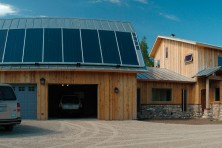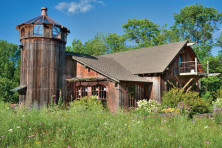State News: Evers Transition, Infant Health, Timber Sales
- Share
- Tweet
- Pin
- Share
Baraboo Holds Meeting to Discuss Photo
More than 100 people attended a community forum in Baraboo on Nov. 15 to discuss a photograph of local high school boys giving what appears to be a Nazi salute just before prom this year. The meeting was organized by concerned citizens after the photo surfaced on social media. The photograph shows a group of boys dressed for their high school prom last spring with many of them stretching their right arms in what critics say is a Sieg Heil salute.
The picture has drawn international attention to the small city in south-central Wisconsin, and community residents and officials with the city and school district are scheduling a series of meetings to discuss the gesture and how it has impacted others. City officials said the meetings are an effort to “collectively acknowledge the deep significance” of the issue. Most of Thursday’s meeting was spent in discussion among smaller groups of attendees, brainstorming how the community should respond to the photo and move forward from the incident. The meeting ended with plans to form a more permanent community organization, with the next meeting date set for Nov. 26.
Gov. Scott Walker addressed the photo Nov. 15 in his first meeting with reporters since losing the Nov. 6 election: “I think it’s just stupid,” Walker said. “They’re just a bunch of idiots. Some are trying to brush it off as youthful indiscretion, but still, they’re idiots.”
Evers Launches Transition Website
Gov.-elect Tony Evers has launched a website to connect with Wisconsin residents as he prepares to take over the governor’s office next year. Evers’ transition team rolled out evers.wi.gov to aid in recruitment of staff for the Evers administration and facilitate a dialogue with Wisconsinites about their goals for the state.
“We want Wisconsin residents to be an active part of their government and share their ideas on moving the state forward,” Evers said. “Our new transition website will make that easy for them to do starting today.”
The site includes information about Evers, an application portal for jobs with his administration, and a form for the public to contact his transition team.
Evers announced some members of his administration earlier this week, including his future chief of staff, his 2018 campaign manager, Maggie Gau. State lawmakers approved $94,600 in state funds for Evers to finance the transition.
The governor-elect is scheduled to be inaugurated at the state Capitol on Monday, Jan. 7.
CDC: Health of Babies Not Improving
Despite efforts to improve infant mortality rates, the national statistic has remained relatively unchanged, according to federal health officials.
Data released by the Centers for Disease Control and Prevention’s National Center for Health Statistics show for every 1,000 infants across the United States, 5.87 died in 2016. This is not a significant change from the previous year. The rate was nearly twice as high for black babies.
Low birth weight was the leading factor in infant mortality, according to the report. Many of the babies were born prematurely.
Premature birth and its complications are the largest contributors to infant death in the U.S. and a major cause of long-term health problems in children who survive, according to the March of Dimes. A premature birth is one that occurs at 37 weeks or less.
Wisconsin’s premature birth rate is lower than the national average. It remained constant at 9.6 percent in 2017, but has been increasing the last five years, said Ashley Mucek from the Wisconsin March of Dimes chapter.
There continues to be a racial gap in infants who are born early or die early. In Wisconsin, the preterm birth rate among black women is 54 percent higher than the rate among all other women. In its 2018 Report Card, March of Dimes looked at six Wisconsin counties with the most births. It noted that the premature birth rate worsened in Milwaukee, Racine and Waukesha counties between 2016 and 2017. But improved in Dane and Outagamie counties. There was no change in Brown county.
National Forest Sells Most Timber Since Early ’90s
Timber sales on the Chequamegon-Nicolet National Forest have increased for the sixth year in a row. The forest sold 128.7 million board feet of timber this past fiscal year.
Forest Supervisor Paul Strong said that’s the most timber sold on the Chequamegon-Nicolet National Forest since the early 1990s. The forest has been able to sell more stands of timber for harvest through an agreement with the Wisconsin Department of Natural Resources under the Good Neighbor Authority, which allows the state to conduct management of national forest land.
The state sold 30.7 million board feet under the agreement, said Jeffrey Olsen, national forest specialist in the Good Neighbor Authority program with the DNR.
“It adds to the economy of the state of Wisconsin because it’s allowing more wood to come on the markets and help the wood product manufacturers in Wisconsin having more supply available to them,” said Olsen.
The forest industry overall accounts for more than 64,000 jobs and $24.7 billion in economic output, according to the DNR’s website. Olsen said the state has set up more than 10,000 acres of timber sales the last several years, generating a little more than $7.25 million for the program. Any revenues that exceed the cost of administering sales go back into projects on the Chequamegon-Nicolet National Forest.
Last year, the Chequamegon-Nicolet National Forest sold 120.5 million board feet of timber valued at $7.72 million. The forest is planning to sell 102 million board feet next year with another 25 million coming through state-administered sales.
Loggers harvested about 14,000 acres of the more than 860,000 acres available for timber harvests in the national forest in 2018.
Wisconsin Public Radio, © Copyright 2018, Board of Regents of the University of Wisconsin System and Wisconsin Educational Communications Board.




